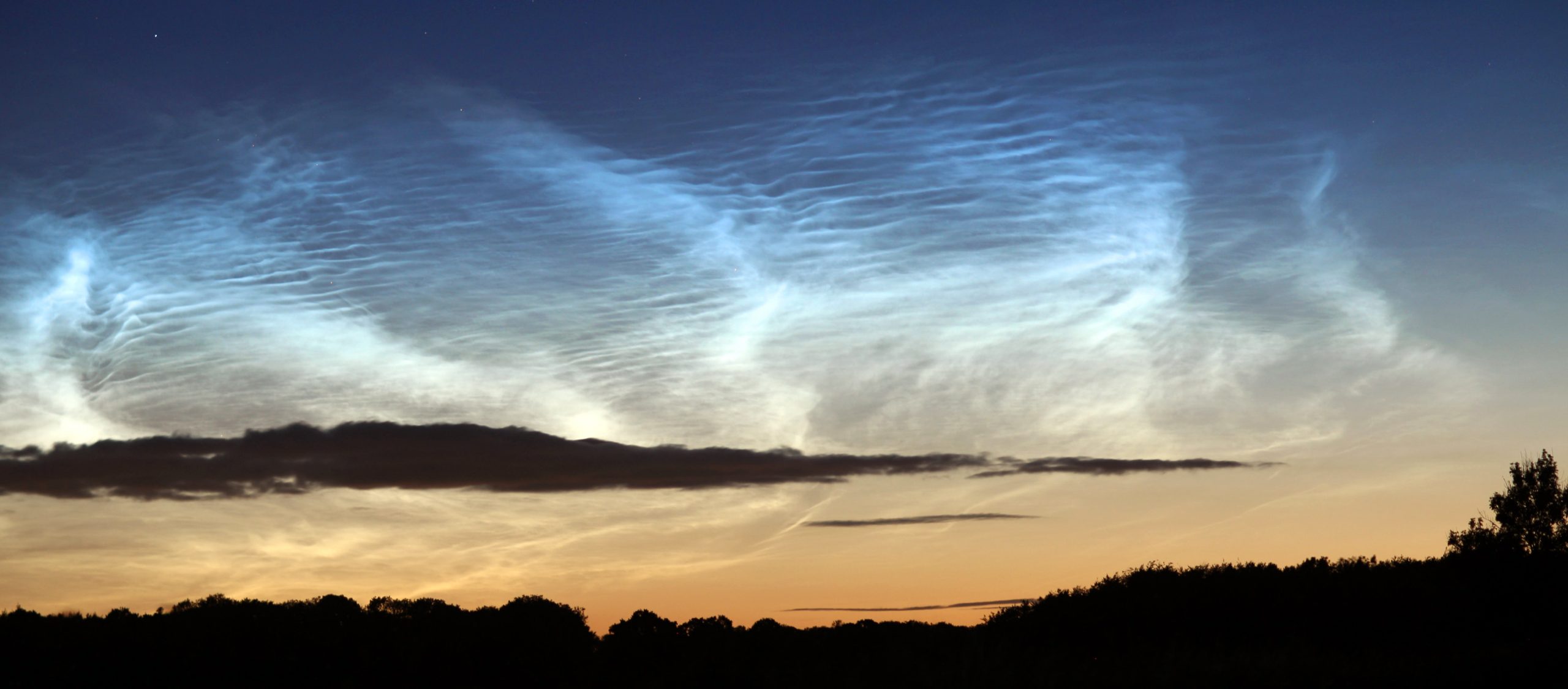Noctilucent cloud over Britain & Western Europe, 2020
2022 June 6
A report of the Aurora & Noctilucent Cloud Section. Director: S. Brantingham.
Noctilucent cloud (NLC) forms in the mesosphere at an altitude of about 83km and appears annually in northern latitudes, between the end of May and the beginning of August. A number of observers, located at widely dispersed locations in the UK and Western Europe, report their sightings to the British Astronomical Association. This paper is an analysis of these observations for the summer months of 2020, together with background information about conditions in the mesosphere which contribute to the formation of polar mesospheric ice: the cause of ground-based sightings of NLC.

Introduction
Noctilucent cloud (NLC) has been observed since 1885 and has been recorded by the British Astronomical Association for many decades, together with other atmospheric phenomena. Over the past 20 years or so, there has been increasing interest
in NLC as its frequency seems to have increased. This rise was noted by NASA, who launched the Aeronomy of Ice in the Mesosphere (AIM) satellite in 2007 to investigate the significance of the phenomenon.
The Cloud Imaging & Particle Size (CIPS) instrument on AIM has provided early warning of ice development in the mesosphere since its launch in 2007. Composite images taken from orbit each day produce maps, known as daisies, which show the development of ice areas over time and also show the drift of these regions, which is related to the relative rotations of Earth and the atmosphere.
In 2020, CIPS images first showed a small area of ice in the mesosphere on May 17, this being the earliest date on which it has appeared since the slightly earlier date of May 15 in 2013. The ice disappeared on May 18 but returned on May 19, and the first NLC sighting was reported from a latitude of 58.4°N, in Estonia, on the night of May 22/23.
The Microwave Limb Sounder (MLS) on NASA’s Aura satellite provides measurements of the temperature and moisture in the mesosphere. This information has been very useful over the past few years as an early indicator of the possible intensity of ice in the mesosphere, and so NLC frequency. In 2020 Dr Lynn Harvey issued a graph for the 2020 NLC season showing that, in the early part of the season, the temperature in the mesosphere was lower and the moisture was higher than average (Figure 1). These early results for 2020 indicated that the temperature and moisture would result in a considerable amount of ice in the mesosphere and this would be reflected by numerous reports of NLC, which may also be seen at lower latitudes than typically expected.
In July, Prof Cora Randall said ‘I think that conditions of temperature and water vapor have been excellent for NLCs this year. Whether that is due to low solar activity or something else is unclear. But between the good conditions and the preponderance
of observers looking for the comet,1 I think we’re seeing more sightings than usual. I [have produced] a plot of the daily PMC frequencies at 80°N from the CIPS instrument, which shows that this has been a very strong year so far’.2 The plot (Figure 2) shows a
comparison of frequency for polar mesospheric cloud in the northern hemisphere, for years 2007 onwards. The 2020 data, shown in red, indicate an early and rapid rise in frequency, which is in keeping with ground-based sightings until mid-July.
The 2020 NLC season
Since 2007, the first year which the CIPS instrument provided data, the average date for the first ground-based observation reported to the BAA Aurora & Noctilucent Cloud Section has been May 24/25. As previously mentioned, the first sighting reported in 2020 was two days earlier than the average but, despite the data given by the MLS showing colder temperatures and more moisture in the mesosphere, this slightly earlier sighting is not significant and does not indicate that the NLC season is likely to extend to an earlier starting date. Following the first reported sighting at 58.4°N, the latitude at which NLC was seen in May quickly became more southerly, and by May 28/29 it had been reported from 50.8°N. The month ended with 25 reports received on May 30/31, and a further 12 on May 31/32. NLC was reported on eight nights in 2020 May, which was significantly more than the average since 2007 of four. The total number of 51 reports received was also greater than for any May month since 2007.
It must be borne in mind that poor sky conditions over the area covered by observers for this report will always have a significant effect on sightings. The author had particularly poor conditions in June, with 19 completely overcast nights and only one which was clear throughout. This may have been worse than in many other areas, but it perhaps explains the rather slow start to June, when there was a low number of reports received with the exceptions of Jun 5/6, 6/7, 16/17 & 19/20, which produced an average of 15 reports on each night.
The outstanding night of June, and indeed of the season, was that of Jun 21/22, during which NLC was widely seen throughout the UK and Europe, resulting in 66 reports. Coincidentally, this date corresponded to the night when most reports were received in 2019, which produced a record number of 104 reports. By Jun 21/22, the most southerly latitude of NLC sightings had reduced to 46.8°N.
A further notable night in the month was Jun 26/27, from which 21 reports were received. NLC was reported on 26 nights in June, which is marginally above the 2007–2019 average of 25 nights.
(Login or click above to view the full illustrated article in PDF format)
| The British Astronomical Association supports amateur astronomers around the UK and the rest of the world. Find out more about the BAA or join us. |
